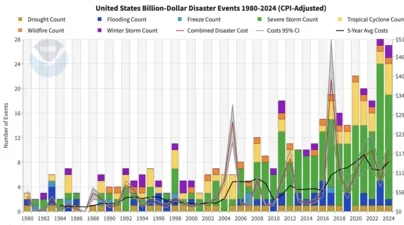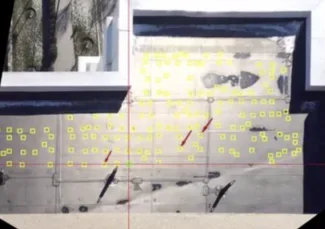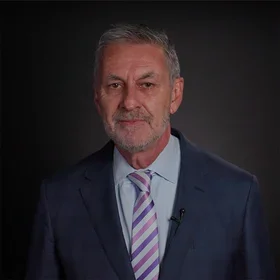Written by Siddhartha Dalal, Professor of Professional Practice, SPS
The applications of AI are growing at an exponential rate driven by advancements in deep learning, which utilizes deep neural networks with billions of parameters. This past spring, I taught a new course, Deep Learning and AI at SPS. I, with others, developed and applied many algorithms in systems like Risk Map, which predicts risks and suggests mitigation strategies. This course covered those algorithms and their applications to language, images, and videos. While you may be familiar with large language models like ChatGPT, I am focused on the next frontier: images and videos.

Figure 1. Dramatic growth in the number of natural disasters costing more than a billion dollars per disaster since 1980 along with the total cost. In 2024 alone, 568 people died in the USA as a result of these disasters, per NOAA.
To effectively respond to these events, we require rapid and accurate situational awareness and robust infrastructure. To find survivors and get them immediate help, drones equipped with cameras (3-D rendering and IR cameras) can quickly gather data. However, manual image analysis is time-consuming and can delay critical assistance. To address this challenge, deep-learning Convolutional Neural Networks (CNNs) algorithms can be used to rapidly analyze drone imagery, identify survivors, and assess damage. This information can be integrated into systems like Risk Maps to accelerate response efforts.
Drones can also be used to identify risky structures, as illustrated in Figure 2, where AI algorithms can be used to identify defective roof fasteners that can make roofs vulnerable in a hurricane.

Figure 2. Defective roof fasteners
Another focus of mine has been on prevention of workplace injury. OSHA reported that for 2023, there were 2,368,900 injury cases in private industry, with 5,283 fatalities. Construction had the most fatalities (1,075) among all industry sectors.
Again, workplace cameras and other sensors using deep-learning AI algorithms with risk-scoring methods can ameliorate this situation. For example, Figure 3 shows holes at a construction site without the guardrails required by NIOSH rule 1926.502(b)(11). New types of deep-learning algorithms coupled with predictive analytics can compute risk scores and provide instantaneous risk assessments that complement the human expertise of safety inspectors.
While these technologies offer tremendous potential, it is crucial to balance technological monitoring with respect for worker privacy and maintaining human oversight. I also discuss these ethical considerations in my course. I welcome collaboration on projects exploring other applications of AI to important societal problems.
About the Author
Siddhartha Dalal’s journey in AI began at Bell Labs. His work on AI as chief scientist led him to C-suite leadership roles at Xerox (research VP), RAND (CTO), and ultimately AIG (senior VP and chief data scientist). He was instrumental in founding Praedicat, Inc., which was recently acquired by Moody’s. In 2017, Dalal embraced a new challenge, joining Columbia University SPS as one of the first professors of professional practice. Dalal is a recipient of numerous honors, including a Meritorious Civilian Service medal from the U.S. Army for service to the nation, a University of Rochester Distinguished Scholar medal, and a Bellcore Fellow medal.
About the Program
Columbia University’s Master of Science in Applied Analytics prepares students with the practical data and leadership skills to succeed. The program combines in-depth knowledge of data analytics with the leadership, management, and communication principles and tactics necessary to impact decision-making at all levels within organizations.
Learn more about the program here. The program is available full-time and part-time, online and on-campus.



